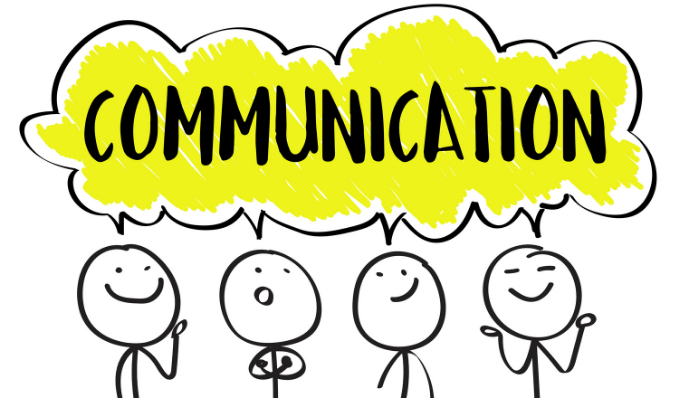 Do you ever wish that you could pause time, take back something you said, and start over? Would you like to be someone who has quick comebacks in conversations, instead of thinking of something good to say 10 minutes later? The holiday season, now in full swing, comes with countless gatherings, celebrations, and–more often than not–the stresses of social interactions. Typical elements of conversation and communication can be tricky for people with ADHD or other neurodivergent individuals; they may interrupt or speak too quickly, space out unintentionally and miss key elements of a conversation, have difficulty processing information, or feel insecure about what they have to say. Learning some useful techniques for listening and speaking more effectively can help neurodivergent individuals improve their interpersonal skills and reduce social anxiety.
Do you ever wish that you could pause time, take back something you said, and start over? Would you like to be someone who has quick comebacks in conversations, instead of thinking of something good to say 10 minutes later? The holiday season, now in full swing, comes with countless gatherings, celebrations, and–more often than not–the stresses of social interactions. Typical elements of conversation and communication can be tricky for people with ADHD or other neurodivergent individuals; they may interrupt or speak too quickly, space out unintentionally and miss key elements of a conversation, have difficulty processing information, or feel insecure about what they have to say. Learning some useful techniques for listening and speaking more effectively can help neurodivergent individuals improve their interpersonal skills and reduce social anxiety.
Social expectations vs. neurodivergent experiences
There’s a general assumption that all people are in complete control of their words, actions and emotions, and that everyone knows the unspoken, unwritten and often mysterious rules of social engagement. However, this doesn’t account for neurodivergent experiences, strengths or challenges with communication. It also neglects to account for the effects that anxiety and depression can have on the body and mind during interactions.
Some neurodivergent people might prefer more direct communication. Others might prefer communicating through art or story. Many prefer social opportunities where they aren’t pressured to make eye contact or sit still, or where they can easily take breaks and then join back in conversation. Just because neurodivergent people might approach social communication differently than a neurotypical person would, doesn’t mean one approach is preferable over the other. Let’s take a more compassionate approach and explore how we can all become more confident communicators.
Verbal and nonverbal communication
 There are two types of communication: verbal and nonverbal. Verbal communication has to do with words we use to explicitly communicate an idea. Nonverbal communication is what we implicitly express through specific behaviors, body language and demeanor. Verbal communication can be difficult enough on its own, but when we also need to track nonverbal queues, like posture, tone, and physical proximity, social interactions can feel overwhelmingly hard. I’ve compiled some tips to make this process easier.
There are two types of communication: verbal and nonverbal. Verbal communication has to do with words we use to explicitly communicate an idea. Nonverbal communication is what we implicitly express through specific behaviors, body language and demeanor. Verbal communication can be difficult enough on its own, but when we also need to track nonverbal queues, like posture, tone, and physical proximity, social interactions can feel overwhelmingly hard. I’ve compiled some tips to make this process easier.
Verbal communication tips:
Entering a conversation:
When asking to join in on a conversation that’s already in progress, be friendly and respectful. Listen and observe before communicating, so you can understand the subject that is being discussed and can get a sense of what’s happening emotionally among the participants.
Participating in a conversation:
Be genuine–be yourself!
Ask questions, but don’t feel the need to conduct an interview. Plus, it might come off as dominating the conversation.

Practicing pausing before making any responses or judgments. Consider validating the other person’s concerns or experiences, and not minimizing them.
If you miss something or get distracted, that’s okay! It happens. Try to come back slowly, by first listening to assess what’s happening. It’s okay to ask someone to repeat something for clarification if needed.
It helps to reflect back part of what you hear, which validates the other person (they feel heard) and helps you remember parts of the discussion. Try using a mirroring statement, such as “So, what you’re saying is...” or, a summarizing statement, like “Oh, wow. You just got that new job!” This reflection will also help compensate for potential wandering attention, because you are sharing some of the details you heard (even if you’ve missed others!).
Avoid giving directives. No one wants to be told what to do. It’s best to gently suggest or ask about a way of doing something instead of telling someone what or how they should act. For example, instead of saying, “You should ask for a promotion or find another job,” try rephrasing to use a softer approach, such as, “Would you consider asking for a promotion? Maybe it’s time to look for another job.”
Monitoring the conversation:

Pace yourself. Try to noticing your communication speed, and whether it seems to work well for the other participant(s). Would talking faster or slower be a helpful adjustment to your or the other person(s)? Their facial expressions might help you monitor their reactions and whether you need to make a change or take a little pause.
Remember, effective communication is a back-and-forth process where participants take turns speaking and listening. Be mindful of how others respond to you to help the conversation flow smoothly.
Exiting a conversation:
Remember, it’s okay to leave at any point during a conversation if you feel uncomfortable or would find a break helpful. When you’re ready to leave, it might help to keep it quick and simply communicate your need to leave: “Great to see you again! I’ve gotta run. See you soon.” Likewise, when someone expresses a need to exit the conversation, respect their needs and avoid prolonging the conversation.
Nonverbal communication tips:
Body language and facial expressions:
Neurotypical people often express interest and engagement by expressing openness and calmness, with relaxed posture and eye contact or by leaning forward. They often express judgment and discomfort by appearing more closed off, with crossed arms or legs, or by looking away. This might also be true for people who are neurodivergent, but some might express themselves differently, which is okay! It’s just something to be aware of.
Practice pausing and being mindful of what the other person(s) may be expressing through their body language, or what your body language might be signaling them. However, don’t draw conclusions from body language alone if you’re not as familiar with an individual, as it can present differently for different people.
Physical proximity:

Keeping a physical distance of about three feet apart is normally accepted as appropriate in most Western cultures, with hands and body parts kept to yourself. Consent would be expected for any closer distance or contact, especially given the current COVID pandemic concerns.
It’s also important to be mindful that some people are highly sensitive to touch and/or can find hugs, for example, to be uncomfortable or painful. If that’s you, don’t feel pressured to engage in any interaction that would cause you discomfort. If you’re a parent, respect your child’s sensitivities and needs by not pushing your child to hug relatives or friends or sit on Santa’s lap this season. See if you can come up with a fun handshake, wave or hello/goodbye phrase instead.
Volume:
How loud are people speaking? Are you speaking louder or quieter than the people around you? Can you hear yourself? Are you inside or outside? Practice paying attention to your tone of voice as well. Find a buddy who can remind you to reflect on your volume or tone with a subtle, pre-arranged cue.
Movements:
 It’s important to maintain control over our body movements and personal space. Bring something small to fidget with if it helps you stay attentive and more engaged in a discussion. Take the time beforehand to prepare a seat if you prefer to sit, or stand up if you feel the need to stand or stretch.
It’s important to maintain control over our body movements and personal space. Bring something small to fidget with if it helps you stay attentive and more engaged in a discussion. Take the time beforehand to prepare a seat if you prefer to sit, or stand up if you feel the need to stand or stretch.
Certain body movements might be noticeably distracting to others at times. If you’re comfortable with it, and feel it would be beneficial, you can let people know that your body may do things that you are unaware of, are out of your control, or that helps you self-regulate. You can make it clear that the movements are not about them. Remember to offer yourself some compassion if you notice yourself feeling insecure by reactions from others.
Make communication easier with APPLE
To better remember all of these tips in social settings, flex your effective communication muscles by remembering the acronym APPLE:
Ask to join:
Ask relevant questions, and assess what’s happening by reading people’s faces.
Physical proximity and volume:
Place yourself appropriately near others, observe their volume and follow along.
Participate:
Use reflective statements to show that you’re listening, and express your genuine curiosity about others’ experiences.
Lay off self-criticism:
Turn down the volume on the internal negative voice that guesses what other people are saying about you, because it’s often wrong! Stay present and engaged with what’s happening in NOW–in the moment.
Enjoy connecting with others:
Take a moment to appreciate your social connections. Practice what you’d like to about yourself and bringing up your personal interests in conversation while also receiving what’s interesting and compelling to others. Conversations are a give and take.
 Becoming a strong and empathic communicator can take practice. Self-awareness, impulse control, emotional regulation and working memory, among other executive functioning skills, can be particularly challenging for neurodivergent folks. Moreover, there are issues with cultural values, social norms and interpersonal dynamics that can be difficult to interpret. With understanding, research, patient instruction and lots of practice, anyone can learn to participate in conversations more appropriately and confidently.
Becoming a strong and empathic communicator can take practice. Self-awareness, impulse control, emotional regulation and working memory, among other executive functioning skills, can be particularly challenging for neurodivergent folks. Moreover, there are issues with cultural values, social norms and interpersonal dynamics that can be difficult to interpret. With understanding, research, patient instruction and lots of practice, anyone can learn to participate in conversations more appropriately and confidently.
Read more blog posts:
Watch ADDitude Q&As on Dr. Saline’s YouTube Channel:
-
- ADHD and Social Anxiety | ADHD Q&A with Psychologist Dr. Sharon Saline
- Transforming ADHD Triggers: From Upset to Reset | Q&A with ADHD Expert Dr. Sharon Saline
- How to Deal with & Educate ADHD Doubters | ADHD Q&A with Clinical Psychologist Dr. Sharon Saline
Shop handouts, seminars & more in Dr. Saline’s Store. https://drsharonsaline.com/product/home-seminar/

 As the holiday season unfolds, my clients and friends express feeling very stressed. Some people have a long list of gifts to buy and wait until the last minute to do their shopping. Some schedule back-to-back social plans and celebrate with gusto. Other folks dislike the holidays altogether and would prefer to hide in bed under the covers until January. In general, everyone seems to be in a state of perpetual motion, running from one thing to the next, trying to get things done and seeing family and friends. This pace is not only challenging to maintain, but it’s also especially hard for kids and adults with ADHD who get easily overwhelmed, even without the holiday fervor.
As the holiday season unfolds, my clients and friends express feeling very stressed. Some people have a long list of gifts to buy and wait until the last minute to do their shopping. Some schedule back-to-back social plans and celebrate with gusto. Other folks dislike the holidays altogether and would prefer to hide in bed under the covers until January. In general, everyone seems to be in a state of perpetual motion, running from one thing to the next, trying to get things done and seeing family and friends. This pace is not only challenging to maintain, but it’s also especially hard for kids and adults with ADHD who get easily overwhelmed, even without the holiday fervor.  Make a master list, and then break it down into shorter ones. Ideally, your family might stop at 1 or 2 places in one trip, but plan for no more than 3-4 different places in one outing. Strategize by mapping out where you need to go beforehand, and group places together that are near each other.
Make a master list, and then break it down into shorter ones. Ideally, your family might stop at 1 or 2 places in one trip, but plan for no more than 3-4 different places in one outing. Strategize by mapping out where you need to go beforehand, and group places together that are near each other.








 We are bombarded by information every moment of every day, which creates what Goleman refers to as the “neural buzz” in our brains. This ‘buzz’ can easily interrupt us and overwhelm our capacity to manage our focus through our ‘thinking brains.’ Children, teens and adults with ADHD have brain systems that are associated with creative mind-wandering. There is some thinking that ‘zoning out’ might actually be a time when innovative connections between new ideas are occurring.
We are bombarded by information every moment of every day, which creates what Goleman refers to as the “neural buzz” in our brains. This ‘buzz’ can easily interrupt us and overwhelm our capacity to manage our focus through our ‘thinking brains.’ Children, teens and adults with ADHD have brain systems that are associated with creative mind-wandering. There is some thinking that ‘zoning out’ might actually be a time when innovative connections between new ideas are occurring.

